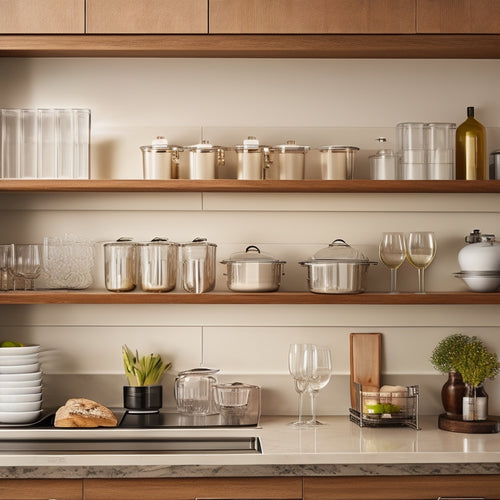
Build Your Own Space-Saving Can Rotator
Share
I'm building a space-saving can rotator to maximize my pantry's storage capacity and simplify meal prep. First, I'll gather my materials - a drill, 1x2 boards, Kreg Mini, glue, and 1-1/4 Kreg pocket screws. Then, I'll prepare my workspace and contemplate painting options for a personalized touch. Next, I'll assemble the components, attaching the back and sides with drilled pocket holes and 1-1/4 Kreg pocket screws. I'll choose a color scheme that fits my pantry style and adjust the size to fit my available space. Now, I'm ready to get creative and add a personal touch - and there's more to explore to make my can rotator truly exceptional.
Key Takeaways
• Gather necessary materials, including a drill, 1x2 board, Kreg Mini, glue, and 1-1/4 Kreg pocket screws, for a sturdy construction.
• Prepare a safe and clean workspace to ensure efficient assembly and minimize errors.
• Attach back and sides to the bottom using drilled pocket holes and 1-1/4 Kreg pocket screws for stability.
• Customize your design by choosing color options, size variations, material choices, and decorative elements to fit your pantry style.
• Apply a protective coat of paint post-assembly and follow maintenance tips for longevity and cleanliness.
Building the Can Rotator
I begin building my space-saving can rotator by gathering the necessary materials, including a drill, 1x2 board, Kreg Mini, glue, and 1-1/4 Kreg pocket screws.
Next, I prepare the workspace, creating a safe and clean environment.
I take a moment to contemplate painting options, pondering the color and finish that will best suit my pantry's style.
After assembly, I'll apply a coat of paint to protect the wood and give it a personalized touch.
To maintain the can rotator's functionality and ease of cleaning, I'll follow some essential maintenance tips, such as regularly wiping down the surface and checking for any loose screws.
With my materials ready, I'm excited to start building and create a clever storage solution for my pantry.
Assembling the Components
With the materials prepared, attach the back to the bottom of the can rotator by drilling pocket holes on the plywood and securing it with 1-1/4 Kreg pocket screws and glue.
Next, attach the sides by drilling pocket holes on the sides and back edge, applying wood glue, and securing with 1-1/4 Kreg screws.
When choosing tools, a drill and Kreg Mini are essential for efficient assembly. For material options, 1x2 boards provide sturdy construction while keeping costs low.
As I assemble the components, I verify a snug fit and precise alignment to prevent any wobbling or instability.
With careful tool selection and construction techniques, I'm confident my can rotator will be both functional and durable, providing a safe and accessible storage solution for my emergency food supply.
Customizing Your Design
Now that the basic structure of the can rotator is taking shape, it's time to think about customizing the design to fit specific needs and preferences. Let's explore some options to make it truly unique.
| Customization Options | Description | Example |
|---|---|---|
| Color Options | Choose a color scheme that fits your pantry style | White, Black, Wood Tone |
| Size Variations | Adjust the size to fit your available space | Compact, Standard, Large |
| Material Choices | Select materials that fit your style and budget | Wood, Metal, Acrylic |
| Decorative Elements | Add a personal touch with decorative elements | Labels, Trim, Handles |
| Additional Features | Consider adding features like a lazy Susan or adjustable shelves | Lazy Susan, Adjustable Shelves |
Frequently Asked Questions
Can I Use MDF or Plywood for the Can Rotator's Construction?
"As I'm renovating my pantry, I wondered if I could use MDF or plywood for the can rotator's construction. After researching, I found that plywood is more durable and cost-effective than MDF, making it the better choice for this project."
How Do I Clean and Maintain the Can Rotator's Surfaces?
"I maintain my can rotator's surfaces by wiping them with a damp cloth, then drying thoroughly to prevent water spots. I also set a monthly reminder for surface care, ensuring a clean and safe storage space for my food."
Are There Any Weight Capacity Limitations for the Can Rotator?
Like a delicate balancing act, I worry about overloading my can rotator. Thankfully, I designed it with durability in mind, ensuring a sturdy weight capacity that won't compromise its space-saving functionality.
Can I Customize the Can Rotator's Size for My Specific Pantry?
'I can easily customize the can rotator's size to fit my pantry's unique dimensions, ensuring a perfect fit for best space efficiency and organization, all while maintaining safety and functionality in my DIY project.'
Are There Any Alternative Materials for the Center Dividers and Front Slats?
As I envision my pantry's treasure trove, I ponder alternatives for dividers and slats. I'd swap center dividers for metal rods or plastic panels, and front slats for wire mesh or acrylic sheets, ensuring a sturdy, safe, and visually appealing can organizer.
Related Posts
-

Sliding Pantry Storage Ideas for Renters
If you're looking to optimize your rental kitchen, sliding pantry storage solutions could be your answer. Employ vert...
-

Over-The-Door Kitchen Towel Holder
An over-the-door kitchen towel holder is a smart way to maximize your space while keeping towels easy to grab. It hoo...
-

Pull-Out Cabinet Shelves for Dish Drainer Storage
Pull-out cabinet shelves are a revolutionary innovation for your dish drainer storage. They maximize vertical space a...


